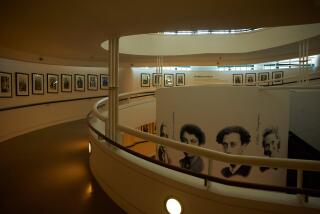This Tibet exhibit toes the party line
- Share via
BEIJING — The museum visitors file past black-and-white photos from the early 20th century showing Tibetan children in filthy rags begging for food on the streets of Lhasa. They click their tongues at a display case with a wooden cage for imprisoning disobedient serfs and wooden blocks used for crushing fingers when the cage wasn’t punishment enough.
Then they move into the second room of the exhibit “Tibet of China: Past and Present,” where color photographs show rosy cheeked children, modern houses and grinning nomads marching with a portrait of Mao Tse-tung.
The exhibit running through July 25 at Beijing’s Cultural Palace of Nationalities is one of the clearest expressions of the Communist Party line on Tibet. There is nothing subtle in the selection of 400 photographs and 160 objects on display, and the explanatory material is unabashed in proclaiming the exhibit’s purpose.
“This exhibition displays the backwardness and the darkness of the old Tibet as well as the development and the progress of the new Tibet,” states a panel at the entrance.
Heavy security greets visitors at the museum, a few blocks west of Tiananmen Square. Although tickets are free, visitors must show an identity card or passport, empty pockets of change and leave water bottles behind. The exhibit has been attracting as many as 1,500 visitors per day, according to the museum. Many of them are children, although the macabre exhibits are enough to induce nightmares.
Besides the cage and torture instruments, there is a mummified hand allegedly cut from a serf, and photographs of a punishment cave filled with scorpions and of a man with his nose cut off.
“See how evil the Dalai Lama is!” a middle-aged woman told a young boy she was leading by the hand, referring to the exiled Tibetan spiritual leader.
The Dalai Lama was 15 years old when the Chinese invaded in 1950, but the exhibit blames him for the ills of pre-Communist Tibet. “Dalai Lama had all kinds of costly foods and wore silk or satin clothes, living a luxurious and dissipated life,” says one panel.
Revered in the West as a Nobel Peace Prize laureate, the 73-year-old Dalai Lama is one of the most reviled figures in Chinese propaganda. Even as his envoys were in Beijing last week trying to revive stalled negotiations, the Communist Party head in Tibet, Zhang Qingli, accused the Dalai Lama of trying to disrupt the upcoming summer Olympics and “destroying Tibet’s stability and political harmony.”
Chinese children are taught from kindergarten that the Communist Party liberated the Tibetans from slavery and that Tibetans are grateful to the Chinese, except for a few malcontents egged on by the Dalai Lama. In the aftermath of an anti-Chinese uprising that began in March, the largest such protest in two decades, the exhibit seemed designed to corroborate the party stance on Tibet.
“Almost everything in that exhibit is pure propaganda,” said John Powers, a scholar at Australian National University and author of the 2004 book “History as Propaganda: Tibetan Exiles versus the People’s Republic of China.” “They’ve taken bits and pieces of history and mixed it all up.”
Though old Tibet was not as idyllic as some exiles claim, Powers says, his research shows that there was no widespread use of torture and that in fact, the Dalai Lama’s predecessor had banned the practice in the late 19th century; he says China’s claims are a “red herring” to deflect attention from its own human rights record. He also says that Tibetan peasants who worked land owned by monasteries or aristocrats were serfs rather than slaves, and could leave if they chose, but that the Chinese have deliberately confused the terms.
“You find these same torture photos throughout Chinese propaganda literature on Tibet, but their provenance is never very clear. They make no attempt to establish factuality,” said Powers, who recently toured the exhibit in Beijing.
The portrayals have provoked complaints from Tibetans.
“The exhibition shows you just a small part of Tibetan history. You can’t deny that some parts of Tibetan history were not very nice, but it wasn’t all like that,” said a well-known Tibetan poet who goes by the single name of Woeser. “They’re not telling the whole story.”
Woeser was most offended by the omission of any mention of the Cultural Revolution, the reign of terror in the late 1960s and early 1970s in which thousands of Tibetan monasteries and artifacts were destroyed and countless Tibetans killed.
The exhibition was organized by the United Front Work Department of the Central Committee of the Communist Party of China and the State Council Information Office. Captions are in English and Chinese, but most of the viewers have been Chinese.
During a visit on a weekday afternoon, there were a dozen people, and those who were questioned expressed no doubt about the accuracy of the message.
“Of course it’s true,” said Wang Shuai, a 30-year-old office worker who was visiting the exhibit with colleagues during a lunch break. “It is history. We learn the same from textbooks.”
--
More to Read
Sign up for Essential California
The most important California stories and recommendations in your inbox every morning.
You may occasionally receive promotional content from the Los Angeles Times.













